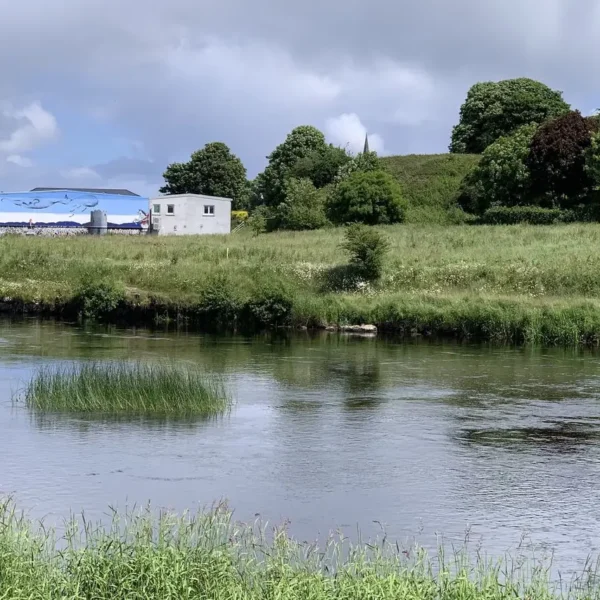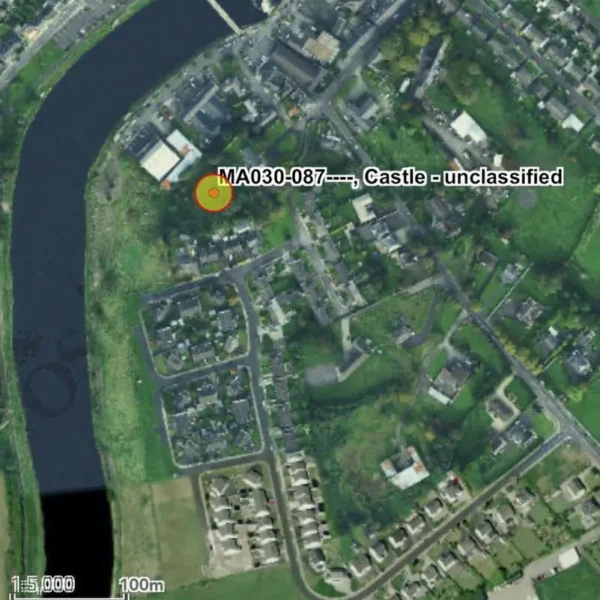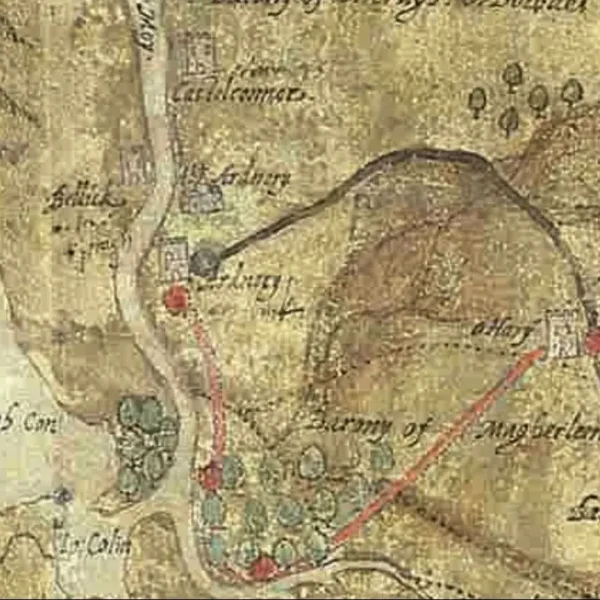Ardnarea Castle
July 9, 2025 2025-07-09 20:38Ardnarea Castle
Ardnarea Castle
The Rediscovered Foundation Stone of O’Dubhda Legacy
Where the Moy River Whispers Tales of Enduring Clan Spirit
The location of Ardnarea, nestled on the Sligo side of the River Moy in Ballina, County Mayo, stands as a poignant symbol of the enduring power and contested history of the Ó Dubhda clan. While the physical castle may be long lost to time, its rediscovered site resonates with centuries of Gaelic ambition, fierce resistance, and the relentless struggle to maintain ancestral lands. This is not merely a historical spot; it is a tangible link to the heart of the Ó Dubhda kingdom, a place that once hosted a fortress which witnessed both triumph and the poignant “vain hope” of a clan determined to reclaim its heritage. This exploration delves into Ardnarea’s storied past, unveiling the significance of its former structure and the legends that bind this location inextricably to the Ó Dubhda.
I. Overview: Journey Through Time at Ardnarea
Ardnarea, located in the vibrant town of Ballina, straddles the historical border between County Mayo and County Sligo, a region deeply intertwined with the Ó Dubhda (also known as O’Dowd or O’Dowda) clan’s ancestral lands.1 Historical records indicate that a castle was constructed by the O’Dowds at Ardnarea in 1447, a vital component of their formidable defensive network, famously described as “20 castles” that ringed their territory across Northwest Connacht.1 For centuries, the Ó Dubhda were Kings of Uí Fiachrach Muaidhe, a sub-kingdom within Connacht, and the fortress at Ardnarea served as a testament to their enduring presence and strategic importance in the region.1 The history of this site is a microcosm of the broader Gaelic struggle against encroaching external powers, embodying the clan’s resilience and their deep-seated connection to the land they fought so fiercely to control.
II. The Storied Past: Ardnarea Through the Ages
A. The O’Dubhda Stronghold: A Symbol of Clan Power
The construction of a castle at Ardnarea in 1447 by the O’Dowds marked a significant assertion of their power and influence in the region.1 As a prominent sept of the northern Uí Fiachrach, the Ó Dubhda had for centuries been masters of their domain, even forging a kingdom that they fortified with numerous castles to hold off invaders.1 The fortress at Ardnarea was one such “10-Pound Castle,” a term often used for smaller Irish castles, though many Ó Dubhda strongholds, including this one, were built on sites with far more ancient histories, sometimes directly over Stone Age and Bronze Age fortifications.1 This blend of ancient lineage and strategic fortification underscored the clan’s deep roots and their pragmatic approach to defense.
B. A Fortress Contested: The “Vain Hope” of Ardnarea
True to the turbulent nature of medieval Ireland, the castle at Ardnarea rarely remained in one set of hands for long, becoming a focal point of intense regional rivalries. Initially part of the Earl Hugh de Lacey’s cantred of Tirereagh and in the immediate possession of Peter Bermingham, the O’Dowds fiercely contested its control.4 Donncadh O’Dowd famously attacked the English at Tireragh, taking Ardnarea and Castleconnor castles “single handed,” driving out the English and redistributing the land to his kinsmen.4
However, this period of O’Dowd control was often fleeting. After Bermingham was driven out, the O’Dowds held the castle at Ardnarea until 1530 when the Burkes seized it.4 Though the O’Dowds briefly recaptured it, Thomas Bourke’s son recovered it the following year, marking the point when the O’Dowds would “never again hold the territory of Ardnaree”.4 This constant struggle for possession gave rise to the poignant proverb, “Suil ui Dubhda le hArd na Ri” (the desire of the O’Dowds for Ard-na-Ree), symbolizing a “vain hope” or a “pointless march in the vain hope of attaining the unattainable”.5 This proverb encapsulates the clan’s enduring aspiration for their ancestral lands despite repeated setbacks.
C. Cromwellian Era and Final Ruin
The O’Dowds continued to occupy the castle at Ardnarea until the tumultuous Cromwellian re-conquest of Ireland in the 17th century.1 Following their eviction during the Cromwellian Plantation of the 1650s, the castle and its lands were granted to Robert Morgan.1 The site of Ardnarea also served as a military base for the Williamite army during the war between King James and William of Orange, further cementing its role in larger national conflicts.1 By the end of the 17th century, the castle ceased to be inhabited, falling into the ruined state from which it eventually disappeared, leaving only its historical site.1 Its ultimate abandonment reflects the broader decline of independent Gaelic power and the profound changes wrought upon the Irish landscape and its native clans.
III. Architectural Marvels: Unveiling Ardnarea’s Former Design
A. The Enduring Structure of an O’Dubhda Fortress
While the physical structure of Ardnarea Castle is no longer standing, historical accounts offer insights into the defensive architecture favored by the Ó Dubhda clan. The castle was described as being three stories high, with exterior measurements of approximately 20 meters in length and 10 meters wide.1 Its walls were notably thick, varying between 1.65 meters and 2.13 meters, a testament to its intended strength.1 Two main features were its subsidiary turrets, strategically placed on diagonally opposed corners, enhancing its defensive capabilities.1 Many original archer slits would have been present, providing a glimpse into its past as a formidable stronghold.1
B. Adaptations and Legacy
While the castle’s core structure reflected its 15th-century origins, it underwent renovations in the 17th century, including the addition of two chimneys.1 This suggests a period of continued habitation and adaptation, even as the political landscape shifted. The castle at Ardnarea was typical of the tower houses built by Irish clan chiefs during the 15th century, designed to assert claims on both land and sea.6 The Ó Dubhda’s network of castles, including Ardnarea, often incorporated or were built upon pre-existing fortifications, such as ringforts, demonstrating a sensible adaptation of ancient sites for continued high-ranking residence and defense.1 This architectural continuity highlights the clan’s deep, ancestral connection to the land and their strategic ingenuity in maintaining their territory against superior forces.1
IV. Legends and Lore: Tales from Ardnarea’s Shadows and Ó Dubhda Echoes
A. The Mermaid of Ard-na-Ree: A Prophecy of Loss and Hope
The most captivating legend directly associated with Ardnarea is the tale of the Mermaid of Ard-na-Ree. This ancient story tells of an Ó Dubhda king who, captivated by a mermaid off the coast of Uí Fiachrach, captured her by seizing her magical cap, a “cockileen,” which made her forget her home beneath the waves.5 She lived with the O’Dowd at Ard-na-Ree Castle and bore him children.5 However, upon accidentally rediscovering her cockileen, the memory of her true home returned, compelling her to return to the sea.5
Before departing, she shared a poignant prophecy: the Ó Dubhda would lose and regain Ard-na-Ree, but only for a short time, leading to the proverb, “Suil le Ui Dubda le Ard-na-Righ” (the desire of the O’Dowds for Ard-na-Ree), symbolizing a vain hope.5 She also foretold that no O’Dowd would ever be drowned.5 This legend, passed down through generations, is a profound symbolic narrative for the clan, reflecting the cyclical nature of loss and aspiration that defined much of their history and their enduring struggle to maintain sovereignty over their ancestral lands.5
B. The “Vain Hope” Proverb: A Clan’s Enduring Desire
The proverb “Suil le Ui Dubda le Ard-na-Righ” is more than just a saying; it is a cultural touchstone for the Ó Dubhda clan, born directly from their repeated attempts to reclaim the castle at Ardnarea and the surrounding territory.5 It speaks to the deep emotional and historical connection the clan has to this specific site, symbolizing their persistent, though often unfulfilled, desire to fully restore their ancient kingdom.5 This narrative reinforces the clan’s identity as one that fought tirelessly for its heritage, even in the face of overwhelming odds, and whose spirit of aspiration continues to resonate through the centuries.
V. Visiting Ardnarea Today: A Glimpse into the Past
A. Location & Access
The historical site of Ardnarea is located in Ballina, County Mayo, on the Sligo side of the River Moy.1 As the site of a long-lost castle, it is generally accessible for external viewing, allowing visitors to appreciate its historical significance.
B. What to Expect
Upon visiting the site of Ardnarea today, one will find the historical location where a significant medieval tower house once stood. While the physical structure is no longer present, the area offers a powerful atmosphere for reflection on centuries of conflict, the resilience of the Ó Dubhda clan, and the enduring spirit of the Irish people. The surrounding area of Ballina, a vibrant town, provides amenities for visitors.
Visitors, particularly those with Ó Dubhda lineage, are encouraged to walk these grounds and contemplate the profound history embedded in the land. Imagine the clan’s ancestors building and defending this stronghold, their hopes and struggles echoing through the very soil. It is a place to connect with the past, to feel the echoes of a powerful Gaelic lineage, and to appreciate the unwavering commitment to heritage that defines the Ó Dubhda clan.
C. Important Considerations
As with any historical site, visitors should wear sturdy shoes, as the terrain can be uneven. Respect for the historical site and any private property in the vicinity is paramount. While the castle is no longer visible, its presence as a historical site serves as a powerful reminder of the Ó Dubhda clan’s deep, multifaceted connection to the land and its history. May the spirit of the ancestors’ resilience and their unwavering commitment to their land continue to inspire all.
Conclusion
The historical site of Ardnarea stands as a profound testament to the tumultuous history of Connacht and the enduring spirit of the Ó Dubhda clan. While the physical castle built by the O’Dowds in 1447 is now lost, its location was a vital part of their extensive defensive network, symbolizing their power and strategic importance in the region. Its history is one of constant contestation, particularly with the Burkes, leading to the poignant proverb “Suil le Ui Dubda le Ard-na-Righ,” which encapsulates the clan’s enduring, though often unfulfilled, desire for their ancestral lands.
The historical accounts of the castle’s architectural features, from its thick walls and turrets to its ancient archer slits, speak to its formidable defensive capabilities and the Ó Dubhda’s adaptive approach to fortification, often building upon prehistoric sites. Beyond its physical structure, Ardnarea is deeply interwoven with the clan’s folklore, most notably the legend of the Mermaid of Ard-na-Ree, which prophesied the clan’s cyclical loss and brief regaining of the castle, further cementing its symbolic significance. Ultimately, the site of Ardnarea, now a place of historical memory, is not merely a relic of the past; it is a proud chronicle of the Ó Dubhda clan’s strategic acumen, their fierce independence, and their deep, multifaceted connection to the land and its history, a connection that continues to resonate through the centuries.
Ardnaree Castle
Árd na Ríogh (Hill of the Kings)
54.10908°N, -9.15529°W
Palmyra Hill, River Moy
Ballina, County Mayo, Ireland
Anglo-Norman fortification
Later Gaelic tower house
c. 1235-1266 (Anglo-Norman)
Rebuilt/occupied by O'Dowds from 1371
Site lost to history
Rediscovered June 6, 2024
Now protected monument
Recently rediscovered site
Protected under National Monuments Acts
Located 100m west of Belleek Woods
O'Dowds captured castle from English in 1371
Contested with Bourkes until 1614
Founded nearby Augustinian Abbey c. 1427
Site of Battle of Ardnaree (1586)




